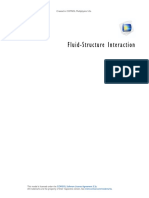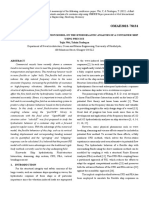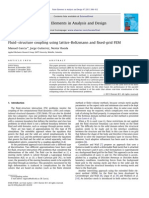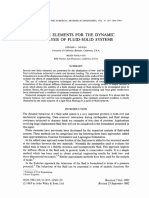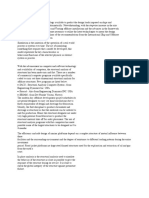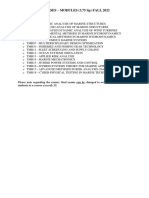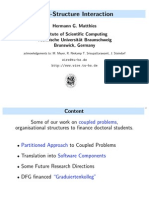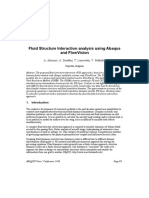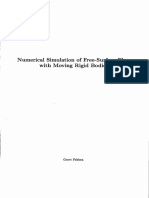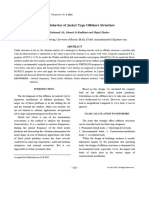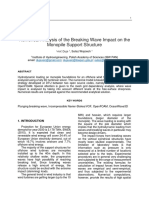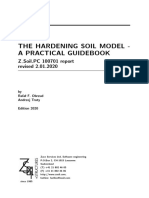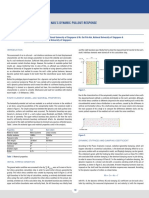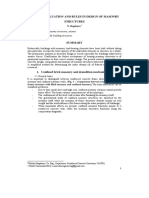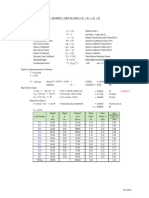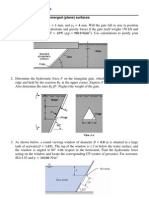ANALYSIS OF WIND FORCE
AND WATER WAVES ON
OFFSHORE STRUCTURES
By Harish Kumar Mulchandani
Under guidance of
Dr. Shibani K. Jha
Assistant professor
Civil Engineering Department
BITS Pilani, Pilani campus
�1. Introduction
With most of the easy gas and oil reserves discovered and prices rebounding,
companies are now drilling far offshore in extreme weather condition
environments. As deep water wells are drilled to greater depths, engineers and
designers are confronted with new problems such as water depth, weather
conditions, ocean currents, equipment reliability, and well accessibility. So
design of offshore structures has been one of the toughest design problems
due to extreme conditions and mainly governed by the dynamic forces.
So at present we are simulate the wind and water forces experienced by
structures using the CFD simulation tool(COMSOL) and performing the
parametric study of the governing parameters.
2. Motivation
The oceans present a unique set of environmental conditions that dominate
the methods, equipment, support, and procedures to be employed in offshore
structural designing. Many literature articles have addressed the extreme
environmental events and adverse exposures as they affect design, still there
is need to evaluate the impact of the combination of wind and water waves.
In recent future the need of offshore wind farms and oil platform has increased
and it is assumed that in 2030 worlds 10% energy would be generated
through offshore wind farms.
At present we have highly sophisticated CFD tools like COMSOL, Ansys
Fluent etc. which have capability of simulating the toughest of design
problems. These tools have different caterings the different needs, being
graduate student in Structural Engineering I have tried to perform analysis of
an offshore structure (a typical monopile) using COMSOL. In the present
study Fluid Structure Interaction (FSI) module have been used to model. It
consist of two sub module Fluid flow module and Solid Mechanics.
�Velocity field and Pressure are calculated using the fluid flow module
whereas the displacement and von mesis surface stress are calculated using
the solid mechanics module.
3. Conceptual Model
Above image shows the conceptual model, Offshore Structure is considered
having fixed base and have the wind forces and water forces from the same
direction. It has been designed taking a lot of assumptions in order to simplify
the design.
Assumptions:
1.
2.
3.
4.
5.
6.
Not accounted for volume forces.
Turbulence in water and wind flow is not accounted.
Linear elastic material of the solid structure.
In few conditions water is only accounted in the upstream.
Direction of Wind and water waves are same.
Velocity profile linearly varying with height.
�Figure shows real offshore structure
being surrounded by water from all
sides and heavy mass at top of
structure.
4. Physics
Fluid Structure Interaction
Fluid-Structure Interaction, phenomena where a fluid and a deformable solid
affect each other. Due to the viscous and pressure forces exerted by the fluid,
the Structure is bending. With the structure undergoing a large deformation,
the fluid flow domain is also changing considerably.
It consist of Fluid flow and Structural mechanics as its sub modules.
�First solves for flow field, giving corresponding velocity fields and pressure
then calculating the surface stresses and displacement of the structure.
5. Arbitrary Lagrangian-Eulerian (ALE) technique
he arbitrary Lagrangian-Eulerian (ALE) is a finite element formulation in
which the computational system is not a prior fixed in space (e.g. Eulerianbased finite element formulations) or attached to material (e.g. Lagrangianbased finite element formulations). ALE-based finite element simulations
can alleviate many of the drawbacks that the traditional Lagrangian-based
and Eulerian-based finite element simulations have.
When using the ALE technique in engineering simulations, the
computational mesh inside the domains can move arbitrarily to optimize the
shapes of elements, while the mesh on the boundaries and interfaces of the
domains can move along with materials to precisely track the boundaries and
interfaces of a multi-material system.
ALE-based finite element formulations can reduce to either Lagrangianbased finite element formulations by equating mesh motion to material
motion or Eulerian-based finite element formulations by fixing mesh in
space. Therefore, one finite element code can be used to perform
comprehensive engineering simulations, including heat transfer, fluid flow,
fluid-structure interactions and metal-manufacturing.
�Adaptive Mesh (User define
Meshing), triangular Meshing
Moving Mesh in the Present
Problem, its an example ALE
Lagrangian specification of the field is a way of looking at fluid motion
where the observer follows an individual fluid parcels as it moves through
space and time.
This can be visualized as sitting in a boat and drifting down a river.
Eulerian specification of the flow field is a way of looking at fluid motion
that focuses on specific locations in the space through which the fluid flows
as time passes.
�This can be visualized by sitting on the bank of a river and watching the
water pass the fixed location.
ALE could be converted into either Eulerian or lagrangian specification
through fixing the space frame.
6. Governing Equations
1. Fluid Flow equations
The fluid flow in the channel is described by the Navier-Stokes equations,
solving for the velocity field u = (u, v) and the pressure, p, in the spatial
(deformed) moving coordinate system:
Where I is the unit diagonal matrix, and F is the volume force affecting the
fluid. The model neglects gravitation and other volume forces affecting the
fluid, so F = 0.
�2. Structural Mechanics Equations
The structural deformations are solved for using an elastic formulation
and a nonlinear geometry formulation to allow large deformations.
The Structure is fixed to the bottom of the fluid channel. All other object
boundaries experience a load from the fluid, given by where n is the
normal vector to the boundary. This load represents a sum of pressure
and viscous forces.
We could see from equations that 3rd equation in fluid flow give us force
exerted by the fluid and 1st equation considers the same force to
calculation the strain in the solid structure.
7. FVM formulation
Diffusion always occurs alongside convection in nature so here we examine
methods to predict combined convection and diffusion. The steady convection
diffusion equation can be derived from the transport equation for a general
property by deleting the transient term.
�Finally converting this equation into algebraic form using nearby nodes
values
8. Modelling
2D Model
Middle blue color
represents solid
structure
�3D Model
Model has water layer up to a certain height and remaining height is covered
with air.
Modelled in both 2D and 3D
Structure height 47.5 m
Water height 0, 20, 45, 100 m
Total height 100m
Boundary Conditions
Fixed Base
At the outflow (right-hand boundary), the condition is p = 0.
At left boundary inlet velocity linearly varying with height is given
v = U* y/H where U is considered as 33.33 m/sec as max velocity
On the solid (nondeforming) walls, no-slip conditions are imposed, u = 0, v
= 0 (fixed constraint)
9. Parametric Study
Height of
water
Displacement
of Structure
Max Surface
stress(KN/m2)
1.28 m
0.930
20 m
2.08 m
1945
45 m
11.69 m
101000
�Displacement of structure
0 meter water height
20 meters water Height
�45 meter water height
Surface Pressure
0 meter Water Height
�20 meter water height
45 meter Water Height
�10.
3D Model
11.
Solver Used
It uses MUMPS solver, two segregated solutions, segregated solution 1, and
segregated solution 2.
Segregated 1 solution comprises of spatial coordinates and displacement
Segregated 2 Solution comprises of Velocity field and pressure.
12.
Future Prospectus
Modelling of torsional effect on offshore structures due do wind and water
waves.
Change of material properties with displacement
Behavior of offshore structures under earthquake conditions
�References
[1] Tetsuro Tamura, Kojiro Nozawa, Koji Kondo, AIJ guide for numerical prediction of wind loads
on buildings, Journal of Wind Engineering and Industrial Aerodynamics, Elsevier, Volume 96,
Issues 1011, OctoberNovember 2008, Pages 19741984
[2] Bert Blocken, Jan Carmeliet, Ted Stathopoulos CFD evaluation of wind speed conditions in
passages between parallel buildingseffect of wall-function roughness modifications for the
atmospheric boundary layer flow, Journal of Wind Engineering and Industrial Aerodynamics,
Elsevier, Volume 95 (2007) 941962
[3] Ben C Gerwick, Construction of Marine and Offshore Structures Taylor & Francis Group 2007
[4] Domic Reeve, Andrew Chadwick, Chris Fleming, Coastal Engineering, CRC publication 2014
[5] COMSOL4.4 user manual
[6] COMSOL Examples Fluid Structure Interaction and Obstacle in a fluid



